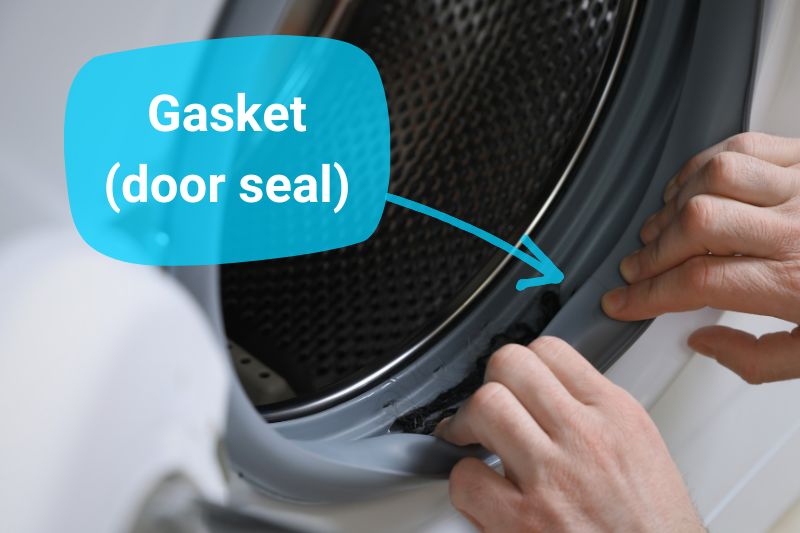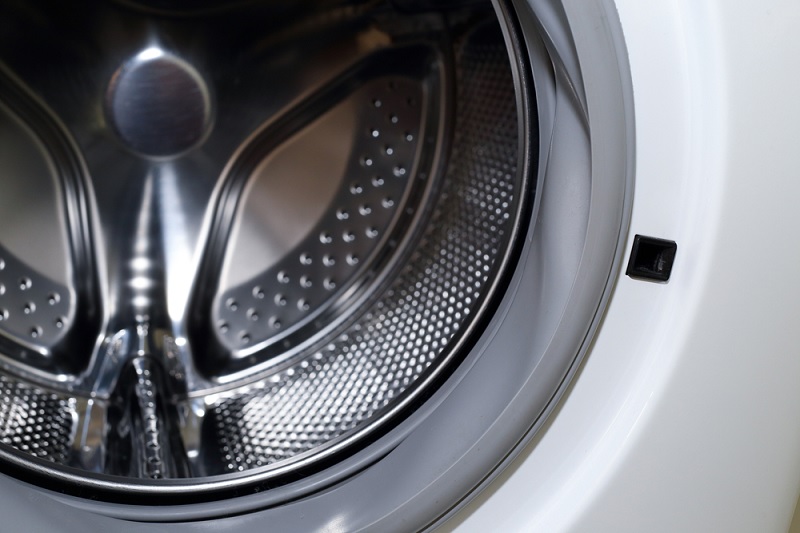Below we’re exploring washing machine gaskets. What they are, if they can become damaged, how to replace them and whether it is worth replacing the gasket at all.
If you have a leak in your washing machine, it could just be the gasket.
So, let’s take a look at this part of the washing machine. It could just save you from having to buy a brand-new machine.
What Is a Washing Machine Gasket?
A washing machine gasket is the rubber seal that goes around the door. It creates a strong steal around the drum and the door to prevent water from leaking out during use.
The gasket is one of the most important parts of your washing machine. Its shape and design ensure that your floor stays dry during the washing and spin cycle of a washing machine.
The washing machine gasket is often referred to as simply the door seal or rubber seal.

Can a Washing Machine Gasket Become Damaged?
Yes, gaskets can become damaged. If a tear or cut forms in the gasket, this can cause the machine to leak. If the gasket dries out and begins to crack, this can also cause leaks.
Commonly, washing machine gaskets are damaged when something catches them. Perhaps the zip of some jeans, or a buckle, for example.
However, cracking in a gasket can also occur when it is exposed to UV light. This can discolour the gasket and, over time, form cracks that will eventually turn into leaks.
Is It Worth Replacing a Washing Machine Gasket?
If your washing machine gasket has been torn or cracked, then you can replace it, and it is well worth doing as well.
The job isn’t too tricky, and buying a replacement gasket isn’t too expensive either. Gaskets start at around £15 and go up to around £80, depending on the make and model of the machine.
You may also need a new seal clamp for the gasket, but these are typically under £10.
So, for under £100, you can replace your washing machine gasket. We’ll get to how to replace it in just a moment. If your washing machine is only a few years old, replacing the new gasket is well worth considering rather than buying a new one.
If you don’t have the confidence to replace the gasket yourself, the average cost of getting the seal replaced by a professional is £100. However, this is very much a ballpark figure.
If the gasket for your washing machine is in the higher price range, you can expect to pay more than this.

How to Replace a Washing Machine Gasket
If you would like to give replacing a washing machine gasket a try, here is how to do it. It is a pretty simple job that anyone with a bit of DIY experience can do and only requires a few basic tools.
1. Remove the lid
Before you start removing anything from your washing machine, it is important that you turn it off and unplug it.
With that done, we can start by removing the lid and the front panels of the washing machine.
The lid is removed by unscrewing a few screws on the back of the machine. You can then lift it off and put it to one side.
2. Remove the top front panel
To remove the top front panel, you first need to remove the soap dispensing drawer (there is a button towards the back of the drawer that you can depress to remove the drawer fully).
There are then a couple of screws on the top of the panel and on the front. Remove these, and the top front panel of your washing machine will come away.
Be careful with this part, as it has the connections for the control panel just behind it. Carefully place the front panel on top of the machine.
You can use some masking tape to tape it to the machine to prevent it from moving around or falling while you replace the gasket.
3. Remove the lower front panel
The screws for the lower front panel are usually located behind the filter door. Open the door, remove the screws, and then the panel should come away.
4. Remove the middle front panel
Next, we need to remove the middle front panel, which is the most complex removal step. First, you need to remove the clamp band that holds the gasket on the drum.
A flat-head screwdriver can be used to prise the gasket out of the way and then used to get hold of the clamp. After this, fold the gasket into the drum to get it out of the way.
This front panel is held on with screws at the top and the bottom (underneath the other two front panels you removed in earlier steps).
Once removed, the front panel will lift off. There are wires on the back of this panel which can be easily disconnected. You can then place the panel to one side.
5. Remove the old gasket
Now you can remove the old gasket. This starts with removing the other clamp band that is holding the gasket onto the drum.
This is tightened into place with a screw, so loosening this will ensure that the clamp comes off without an issue. With this removed, you can unclip the gasket and pull it out.
6. Install the new gasket
To install the new gasket, you need to fit it onto the drum and replace the clamp band, tightening the screw until the gasket is firmly in place.
Next, fold the gasket into the drum, and grab the front panel that you removed last. Reconnect the wires to this panel and put it in place, using the screws at the top and bottom to secure it.
You can then bring the gasket out of the drum and tuck it into the outside edge.
You can now replace the other clamp band, ensuring it is firmly in place. Using a flat-head screwdriver will help with this step.
7. Reinstall the rest of the panels
Now you simply need to work backwards, replacing all the panels that you removed and, finally, the lid. The gasket will be firmly in place and ready to be tested with a load of washing.
Well, there is how to replace a washing machine gasket. We hope this look at what a washing machine gasket is and whether it is worth replacing has been helpful.
For more articles about fixing common issues with household appliances and whether it is worth it or not, please explore In The Wash further. We have loads of articles like this about washing machines, tumble dryers, dishwashers and more.
Oh, and if your appliance isn’t repairable, we also have lists of the best household appliances available in the UK right now too.

In The Wash is your guide to the best laundry and cleaning products, tips and tricks. Our mission is to solve the UK’s cleaning and laundry dilemmas!






